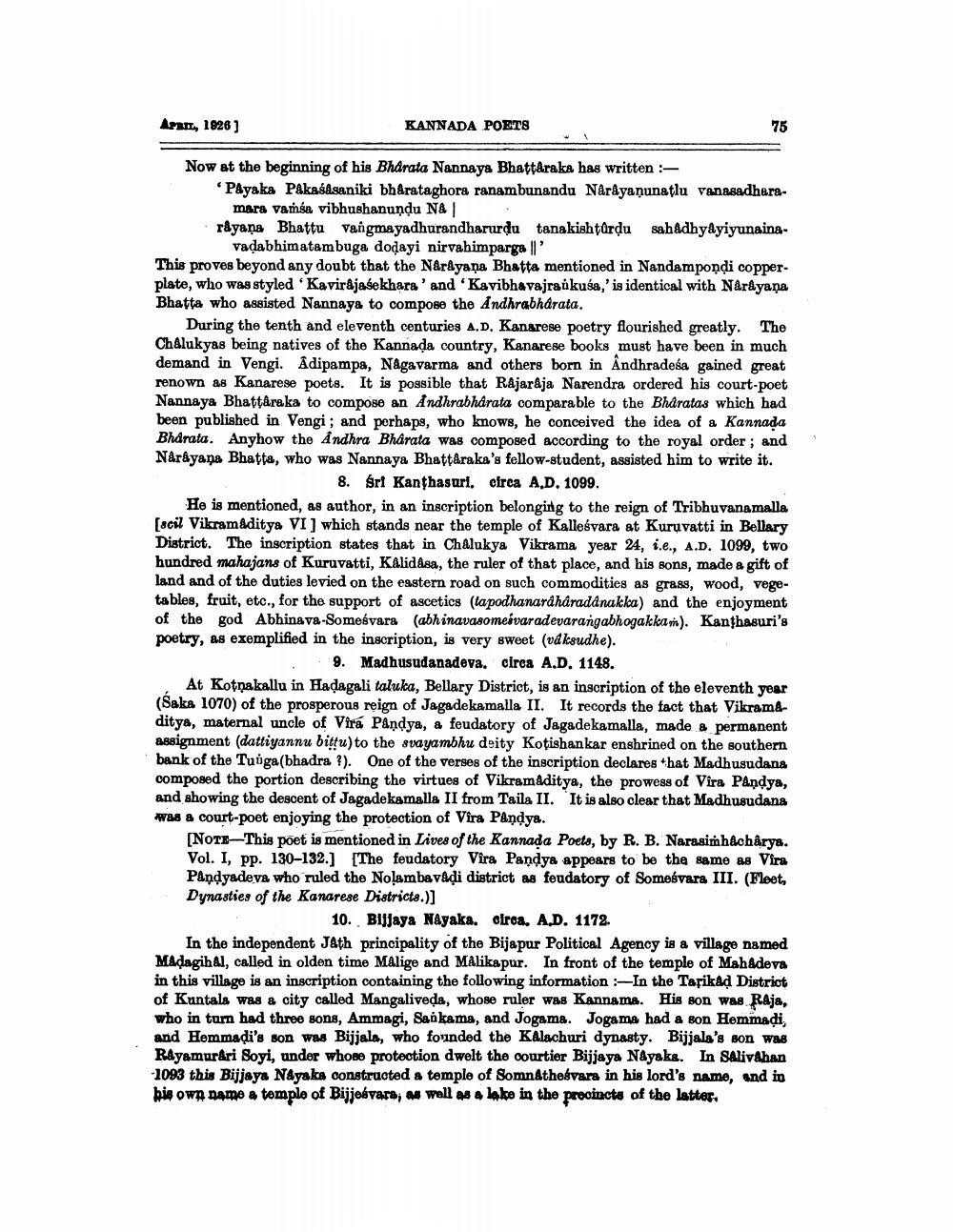________________
APRIL, 1926 )
KANNADA POETS
15
188.
Now at the beginning of his Bharata Nannaya Bhattaraka has written -
PAyaka Pakaśásaniki bharataghora ranambunandu Narayaņunatlu Vanasadhura
mara vaša vibhushanundu NA rayana Bhattu Vangmayadhurandharurdu tanakishtardu sahadhyayiyunaina
vadabhimatambuga dodayi nirvahimparga l' This proves beyond any doubt that the Narayana Bhatta mentioned in Nandampondi copperplate, who was styled 'Kavirajasekhara' and 'Kavibhavajra ukusa,' is identical with Narayana Bhatta who assisted Nannaya to compose the Andhrabharata.
During the tenth and eleventh centuries A.D. Kanarese poetry flourished greatly. The Chalukyas being natives of the Kannada country, Kanarese books must have been in much demand in Vengi. Adipampa, Nagavarma and others born in Andhradeśa gained great renown as Kanarese poets. It is possible that Rajaraja Narendra ordered his court-poet Nannaya Bhattâraka to compose an Andhrabharata comparable to the Bharatas which had been published in Vengi ; and perhaps, who knows, he conceived the idea of a Kannada Bhdrata. Anyhow the Andhra Bharata was composed according to the royal order; and Narayana Bhatta, who was Nannaya Bhattaraka's fellow-student, assisted him to write it.
8. Sri Kanthasari, circa A.D. 1099. He is mentioned, as author, in an inscription belonging to the reign of Tribhuvanamalla [scil Vikramaditya VI) which stands near the temple of Kalleśvara at Kuruvatti in Bellary District. The inscription states that in Chalukya Vikrama year 24, i.e., A.D. 1099, two hundred mahajans of Kuruvatti, Kalidasa, the ruler of that place, and his sons, made a gift of land and of the duties levied on the eastern road on such commodities as grass, wood, vegetables, fruit, etc., for the support of ascetics (lapodhanardharadanakka) and the enjoyment of the god Abhinava-Somesvara (abhinavasomesvaradevarangabhogakkan). Kanthasuri's poetry, as exemplified in the inscription, is very sweet (vdksudhe).
9. Madhusudanadeva. circa A.D. 1148. At Kotņakallu in Hadagali taluka, Bellary District, is an inscription of the eleventh year (Saka 1070) of the prosperous reign of Jagadekamalla II. It records the fact that Vikramaditya, maternal uncle of Vira Pandya, a feudatory of Jagadekamalla, made a permanent assignment (dattiyannu bittu) to the svayambhu deity Kotishankar enshrined on the southern bank of the Tunga(bhadra ?). One of the verses of the inscription declares that Madhusudana composed the portion describing the virtues of Vikramaditya, the prowess of Vira Pandya, and showing the descent of Jagadekamalla II from Taila II. It is also clear that Madhusudana was a court-poet enjoying the protection of Vira Pandya.
[NOTE-This poet is mentioned in Lives of the Kannada Poets, by R. B. Narasimhacharya. Vol. I, pp. 130-132.] [The feudatory Vira Pandya appears to be the same as Vira Pandyadeva who ruled the Nolamba vadi district as feudatory of Somesvara III. (Fleet, Dynasties of the Kanarese Districts.)]
10. Bijjaya Nayaka. ciroa, A.D. 1172. In the independent Jath principality of the Bijapur Political Agency is a village named MAdagih Al, called in olden time MAlige and Malikapur. In front of the temple of Mahadeva in this village is an inscription containing the following information - In the Tarikad District of Kuntals was & city called Mangaliveda, whose ruler was Kannama. His son was Raja, who in turn had three sons, Ammagi, Sankama, and Jogama. Jogama had a son Hemmadi, and Hemmadi's son was Bijjala, who founded the KAlachuri dynasty. Bijjala's son was Reyamur&ri Soyi, under whose protection dwelt the courtier Bijjaya Nayaks. In Salivahan -1093 this Bijjaya Nayaka constructed a temple of Somnatheśvara in his lord's name, and in his own name a tomple of Bijjesvara, w well as a lake in the precincts of the latter,




